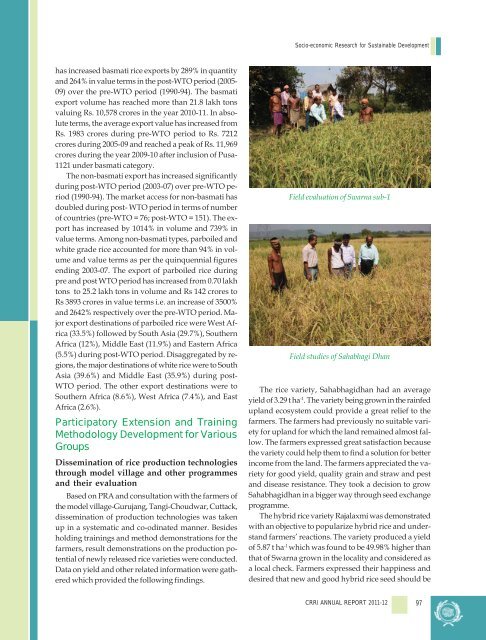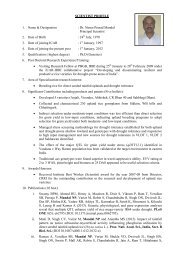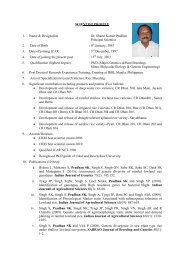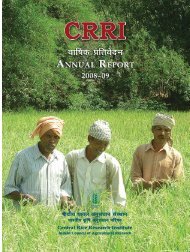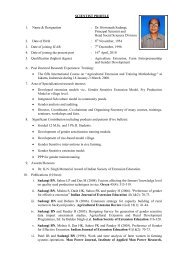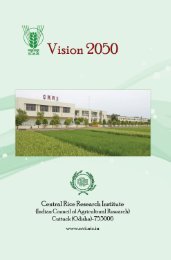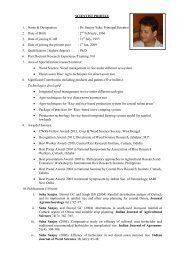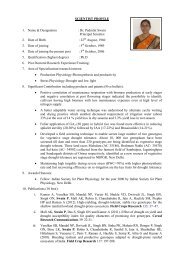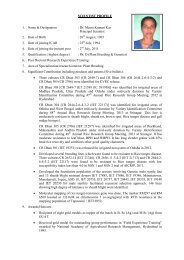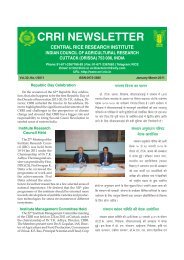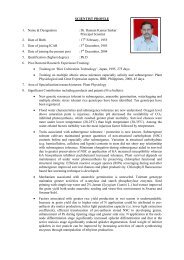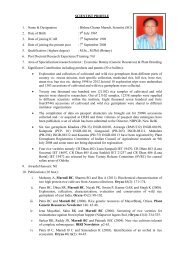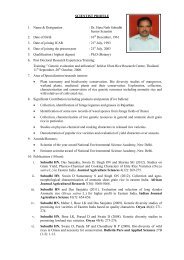Central Rice Research Institute Annual report...2011-12
Central Rice Research Institute Annual report...2011-12
Central Rice Research Institute Annual report...2011-12
You also want an ePaper? Increase the reach of your titles
YUMPU automatically turns print PDFs into web optimized ePapers that Google loves.
Socio-economic <strong>Research</strong> for Sustainable Development<br />
has increased basmati rice exports by 289% in quantity<br />
and 264% in value terms in the post-WTO period (2005-<br />
09) over the pre-WTO period (1990-94). The basmati<br />
export volume has reached more than 21.8 lakh tons<br />
valuing Rs. 10,578 crores in the year 2010-11. In absolute<br />
terms, the average export value has increased from<br />
Rs. 1983 crores during pre-WTO period to Rs. 72<strong>12</strong><br />
crores during 2005-09 and reached a peak of Rs. 11,969<br />
crores during the year 2009-10 after inclusion of Pusa-<br />
1<strong>12</strong>1 under basmati category.<br />
The non-basmati export has increased significantly<br />
during post-WTO period (2003-07) over pre-WTO period<br />
(1990-94). The market access for non-basmati has<br />
doubled during post- WTO period in terms of number<br />
of countries (pre-WTO = 76; post-WTO = 151). The export<br />
has increased by 1014% in volume and 739% in<br />
value terms. Among non-basmati types, parboiled and<br />
white grade rice accounted for more than 94% in volume<br />
and value terms as per the quinquennial figures<br />
ending 2003-07. The export of parboiled rice during<br />
pre and post WTO period has increased from 0.70 lakh<br />
tons to 25.2 lakh tons in volume and Rs 142 crores to<br />
Rs 3893 crores in value terms i.e. an increase of 3500%<br />
and 2642% respectively over the pre-WTO period. Major<br />
export destinations of parboiled rice were West Africa<br />
(33.5%) followed by South Asia (29.7%), Southern<br />
Africa (<strong>12</strong>%), Middle East (11.9%) and Eastern Africa<br />
(5.5%) during post-WTO period. Disaggregated by regions,<br />
the major destinations of white rice were to South<br />
Asia (39.6%) and Middle East (35.9%) during post-<br />
WTO period. The other export destinations were to<br />
Southern Africa (8.6%), West Africa (7.4%), and East<br />
Africa (2.6%).<br />
Participatory Extension and Training<br />
Methodology Development for Various<br />
Groups<br />
Dissemination of rice production technologies<br />
through model village and other programmes<br />
and their evaluation<br />
Based on PRA and consultation with the farmers of<br />
the model village-Gurujang, Tangi-Choudwar, Cuttack,<br />
dissemination of production technologies was taken<br />
up in a systematic and co-odinated manner. Besides<br />
holding trainings and method demonstrations for the<br />
farmers, result demonstrations on the production potential<br />
of newly released rice varieties were conducted.<br />
Data on yield and other related information were gathered<br />
which provided the following findings.<br />
Field evaluation of Swarna sub-1<br />
Field studies of Sahabhagi Dhan<br />
The rice variety, Sahabhagidhan had an average<br />
yield of 3.29 t ha -1 . The variety being grown in the rainfed<br />
upland ecosystem could provide a great relief to the<br />
farmers. The farmers had previously no suitable variety<br />
for upland for which the land remained almost fallow.<br />
The farmers expressed great satisfaction because<br />
the variety could help them to find a solution for better<br />
income from the land. The farmers appreciated the variety<br />
for good yield, quality grain and straw and pest<br />
and disease resistance. They took a decision to grow<br />
Sahabhagidhan in a bigger way through seed exchange<br />
programme.<br />
The hybrid rice variety Rajalaxmi was demonstrated<br />
with an objective to popularize hybrid rice and understand<br />
farmers’ reactions. The variety produced a yield<br />
of 5.87 t ha -1 which was found to be 49.98% higher than<br />
that of Swarna grown in the locality and considered as<br />
a local check. Farmers expressed their happiness and<br />
desired that new and good hybrid rice seed should be<br />
CRRI ANNUAL REPORT 2011-<strong>12</strong><br />
97


